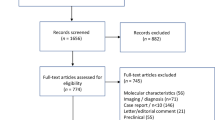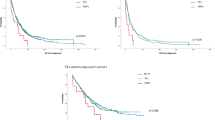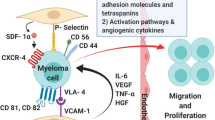Abstract
The clinical features and response to therapy of 32 Chinese patients with localised plasmacytoma are presented, and a comparison between extramedullary plasmacytoma (EMP) and solitary plasmacytoma of bone (SPB) is made. Twenty-two patients had SPB and ten had EMP, accounting for 9% of all of our plasma cell neoplasms. Both groups had a male predominance with a median age of 54 years for SPB and 63 years for EMP. The common sites of SPB included vertebral bodies (15) and the skull (4). Most EMPs occurred in the oronasopharynx (6) and paranasal sinuses (2). An M-protein was detected in eight patients with SPB and in six with EMP. Seventeen patients with SPB and seven with EMP received radiation therapy, and all achieved initial local control. The pattern of failure in 22 patients with SPB manifested as local recurrence in two, multiple bone metastases without bone marrow plasmacytosis in two, multiple EMP progression in two, and development of multiple myeloma (MM) in one. There were two local recurrences, one further solitary bone involvement and one MM conversion in the EMP group. Local recurrence or dissemination was associated with the appearance of M-protein or an increase in the M-protein level in both groups. There was no significant difference in M-protein status or incidence and patterns of failure between the two groups. Patients with EMP had a more favourable overall survival than those with SPB (P = 0.03). The 5 year disease-free survival rate was 79% for EMP and 58% for SPB (P = 0.53). Patients aged less than 60 years had a better overall survival in the SPB group, but location of tumour, presence of M-protein, radiation dose and chemotherapy did not influence prognosis in either group. Our results indicate that adequate local therapy can result in long-term survival with a low frequency of MM progression for patients with localised plasmacytomas, and both EMP and SPB appear to be similar in terms of frequency and patterns of failure.
This is a preview of subscription content, access via your institution
Access options
Subscribe to this journal
Receive 24 print issues and online access
$259.00 per year
only $10.79 per issue
Buy this article
- Purchase on Springer Link
- Instant access to full article PDF
Prices may be subject to local taxes which are calculated during checkout
Similar content being viewed by others
Author information
Authors and Affiliations
Rights and permissions
About this article
Cite this article
Shih, L., Dunn, P., Leung, W. et al. Localised plasmacytomas in Taiwan: comparison between extramedullary plasmacytoma and solitary plasmacytoma of bone. Br J Cancer 71, 128–133 (1995). https://doi.org/10.1038/bjc.1995.26
Issue Date:
DOI: https://doi.org/10.1038/bjc.1995.26
This article is cited by
-
Serum paraprotein persistence and size determine outcome in a cohort of patients with a modern definition of plasmacytoma with up to 19 years of follow up
Blood Cancer Journal (2021)
-
Retrospective analysis of plasmacytoma in Kansai Myeloma Forum Registry
International Journal of Hematology (2020)
-
Clinicopathological spectrum of solitary Plasmacytoma: a single center experience from coastal India
BMC Cancer (2019)
-
Impact of radiation dose on local control and survival in extramedullary head and neck plasmacytoma
Radiation Oncology (2019)
-
Unexpected response of extramedullary plasmacytoma in patients with lung cancer who received nivolumab
Annals of Hematology (2019)



